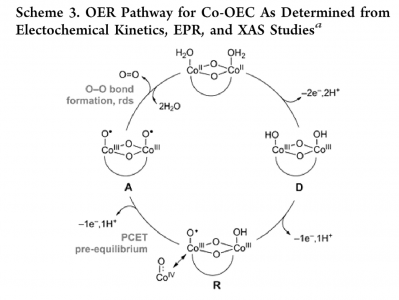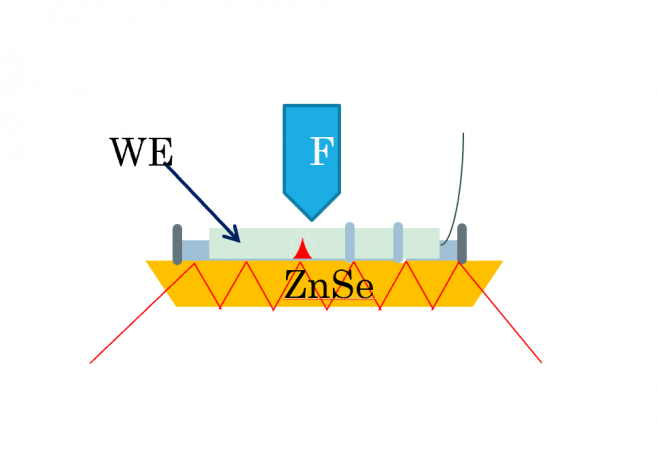Difference between revisions of "Mechanistic Study of Water Oxidation"
| Line 8: | Line 8: | ||
=Background= | =Background= | ||
| + | Water oxidation is one half reaction of a larger reaction known as water splitting. Water splitting involves the breaking and rearranging of the bonds in water to form oxygen (O<sub>2</sub>) and hydrogen (H<sub>2</sub>). Water oxidation focuses specifically on the evolution of oxygen. In order to facilitate the oxygen evolution reaction (OER), catalysts are typically used. For this project, a cobalt oxide catalyst was chosen due to its abundance in the earth's crust and because it has been heavily studied within the literature as a catalyst for water oxidation. Shown below is a proposed pathway of water oxidation on a cobalt phosphate catalyst (left) and two proposed mechanisms for the oxygen oxygen bond forming step from ''J. Am. Chem. Soc''. '''2016''', 138, 4229-4236. | ||
| + | |||
| + | <gallery mode="packed-hover" heights='200'> | ||
| + | File:OER pathway.PNG|OER Pathway | ||
| + | File:proposed mechanisms.PNG|Proposed Mechanisms for Oxygen Bond Forming Step | ||
| + | </gallery> | ||
| + | |||
| + | For the two proposed mechanisms, the intramolecular oxygen coupling (IMOC) and the water hydrogen atom abstraction (WHAA), it should be noted that one key difference between the two is that the WHHA utilizes water within the mechanism. As this step is rate determining, we chose to begin the study by altering water activity to see if we can distinguish between the two mechanisms. | ||
=Electrochemistry= | =Electrochemistry= | ||
Revision as of 14:30, 8 August 2019
This page was created to summarize Seth Croslow's REU experience at Boston College for the 2019 Summer
Personal Information
- Student: Seth Croslow
- Mentor: Chaochao Lang
- PI: Dr. Dunwei Wang
- College: Boston College
- Dates: June 2 - August 9, 2019
Background
Water oxidation is one half reaction of a larger reaction known as water splitting. Water splitting involves the breaking and rearranging of the bonds in water to form oxygen (O2) and hydrogen (H2). Water oxidation focuses specifically on the evolution of oxygen. In order to facilitate the oxygen evolution reaction (OER), catalysts are typically used. For this project, a cobalt oxide catalyst was chosen due to its abundance in the earth's crust and because it has been heavily studied within the literature as a catalyst for water oxidation. Shown below is a proposed pathway of water oxidation on a cobalt phosphate catalyst (left) and two proposed mechanisms for the oxygen oxygen bond forming step from J. Am. Chem. Soc. 2016, 138, 4229-4236.
For the two proposed mechanisms, the intramolecular oxygen coupling (IMOC) and the water hydrogen atom abstraction (WHAA), it should be noted that one key difference between the two is that the WHHA utilizes water within the mechanism. As this step is rate determining, we chose to begin the study by altering water activity to see if we can distinguish between the two mechanisms.
Electrochemistry
Fourier-Transform Infrared Spectroscopy
Configurations
For FTIR experiments, we began using a custom Otto Configuration that consisted of a ZnSe ATR crystal onto which we placed an FTO coated glass electrode with our cobalt catalyst face down. This, however, had large background noise and prevented evolved oxygen from escaping. We then switched to the Kretschmann Configuration which utilized a silicon ATR crystal plated with a gold film onto which our catalyst was then deposited. This configuration reduced some of the background noise and allowed oxygen to escape into the electrolyte solution.
Electrochemical Quartz Crystal Microbalance
Useful Articles
- Mechanistic Studies of the Oxygen Evolution Reaction by a Cobalt-Phosphate catalyst at neutral pH
- EPR evidence for co(IV) species produced during water oxidation at neutral pH
- Fe (Oxy)hydroxide oxygen Evolution Reaction Electrocatalysis Intrinsic Activity and the Roles of Electrical Conductivity, Substrate, and Dissolution
- On the chemical state of Co oxide electrocatalysts during alkaline water splitting
- Time-resolved observations of water oxidation intermediates on a cobalt oxide nanoparticle catalyst
- Unified structural motifs of the catalytically active state of Co(oxyhydro)oxides during the electrochemical oxygen evolution reaction



